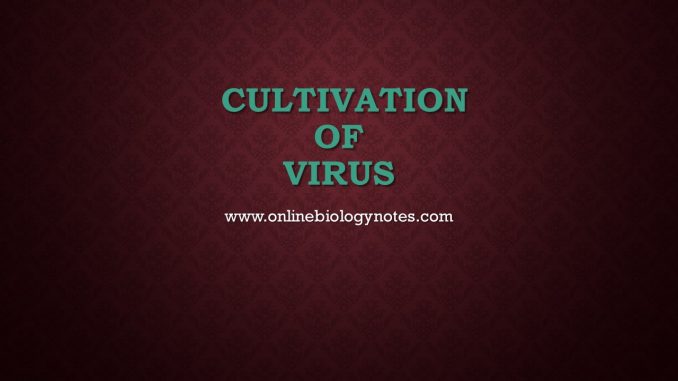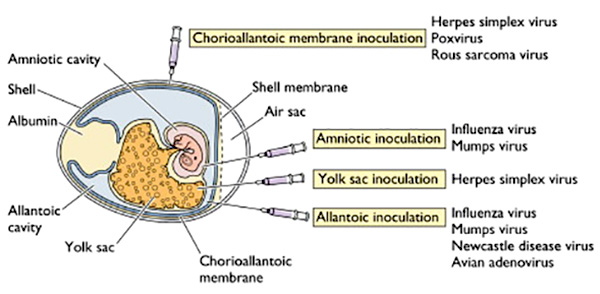
Cultivation of virus
Virus lacks its independent metabolism and they can only replicates inside host cell, so viruses cannot be cultured in non-living medium as bacteria and fungi. Virus can only be cultured in embryonated egg, cell line culture and animal inoculation.
Techniques of virus cultivation
- Animal inoculation
- Embryonated egg culture
- Cell culture
1. Animal inoculation:
- Animal inoculation is one of the primary method for isolation of certain viruses and for study of pathogenesis of certain viral diseases.
- Lab mice (white mice) particularly suckling one are animal of choice for virus cultivation. Suckling mice of age less than 48 hrs are used for culture of Toga virus and Coxsackie virus.
- Other animals such as hamsters, Guinae pig, Chimpanzee etc are sometimes used as alternative for virus culture.
- After inoculation of virus sample, the animals are observed for symptoms of disease till death. And finally virus is isolated from tissue of animal.
2. Embryonated egg culture:
- For virus cultivation, an egg embryo of 7-12 days is used.
- At first egg is kept in incubator for embryo development up to 7-12 days and then virus sample is inoculated into the egg.
- Opening in egg should be shield with paraffin and it is incubated for sufficient time.
- Virus can be cultured in different parts of embryonated egg, such as choriallontoic membrane, amniotic sac, allantoic cavty or yolk sac depending upon types of virus.

i. Chorioallontoic membrane (CAM):
- Pox virus are cultured in choriallontoic membrane.
- The growing virus produce grey-white lesions called Pocks.
- Each Pock is developed by a single virus.
- The number of pocks indicates the number of virus present in inoculated sample.
ii. Allantoic cavity:
- Viruses such as Influenza virus, Mumps virus, Yellow fever virus and Rabies virus are cultivated in allantoic cavity.
- Allantoic cavity culture of virus is mainly done for vaccine preparation, to obtain large amount of virus load.
iii. Amniotic cavity:
- Influenza virus are cultured in amniotic cavity for isolation of virus from clinical sample.
iv. Yolk sac:
- Herpes virus is cultured by inoculating in yolk sac.
- This is also used for cultivation of some bacteria such as Chlamydia and Rickettsia.
3. Cell culture (tissue culture) technique:
- This technique is most commonly used technique for cultivation of virus.
- There are three types of cell culture technique.
i. Organ culture:
- Small bits of organ from human or animal is maintained in tissue culture media.
- This technique is used in specific purposes only. For eg, to culture Corona virus tracheal ring culture is done.
ii. Explant culture:
- In this small fragment of tissue is extracted from human or animal and used for virus culture.
- This technique is very rarely used.
iii. Cell line culture:
- This is the most commonly used technique.
- Cell line culture is routinely used in lab for virus culture, isolation and identification.
- In cell line culture, at first growth media is prepared by maintaining balanced salt concentration, all essential aminoacids, glucose, buffering agents, some antibiotic, serum etc.
- Some tissue fragment is obtained, it is trypsionised to dissociate cells.
- The dissociated cell are washed and suspended in culture media in a tube or petriplates and incubated for sufficient time.
- On incubation, cell divides and spread out on the glass surface to form a confluent mono-layer of cells, which is now used for virus culture.
On the basis of origin, chromosomal characteristics and number of generation through which cell culture can be maintained, cell line culture are of three types.
I. Primary cell line
II. Semi-continuous (diploid) cell line
III. Continuous cell line
I. Primary cell line:
- These are normal cells, obtained from fresh organ of animals or human and cultured.
- Once the cell attached to the surface of culture vessel, they divides by mitosis until confluent mono-layer of cells covers the surface.
- These cells are capable of limited growth for limited generation. They cannot be maintained in serial sub culture.
- These primary cell line culture is used for isolation of virus and for preparation of vaccines.
- Examples: Monkey kidney cell line, Human amnion cell line, etc
II. Semi-continuous cell line (Diploid cell):
- These cell are fibroblastic cell.
- They are diploid cell containing same number of chromosome as the parent cell.
- Fibroblastic cells are obtained from embryo tissue.
- These diploid cell can be sub cultured for limited generation.
- There is a rapid cell division and after 50 serial sub culture, they undergoes senescence.
- The diploid cell are susceptible for wide range of Human virus culture and also used for vaccine production.
- Examples: Rhesus embryo cell, human embryonic lung strain, etc
III. Continuous cell line:
- These are cells of single type capable of infinite growth in vitro.
- These are usually cancer cell derived from cancerous tissue. These cells grow faster and they are haploid cells.
- They are termed as continuous cell line as they can be serially sub culture for infinite generation without going senescence.
- Examples; HeLa cell is obtained from cervical cancer, HEP-2 (Humman Epithelioma of larynx cell line), Vero (Vervet monkey) kidney cell lines, BHK-21 (Baby Hamster Kidney cell line).
- Continuous cell line is maintained by serial sub culture or by deep freezing at -70C, so that these cell be reused when necessary.
- Continuous cell line is used for virus culture but it is not used for vaccine preparation because vaccine prepared by continuous cell culture are not considered safe to Human use.
